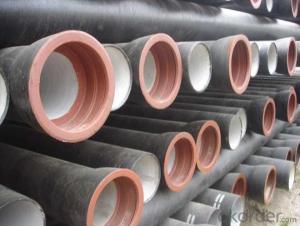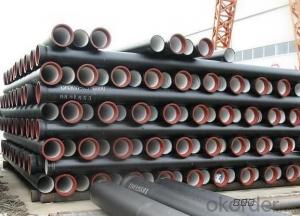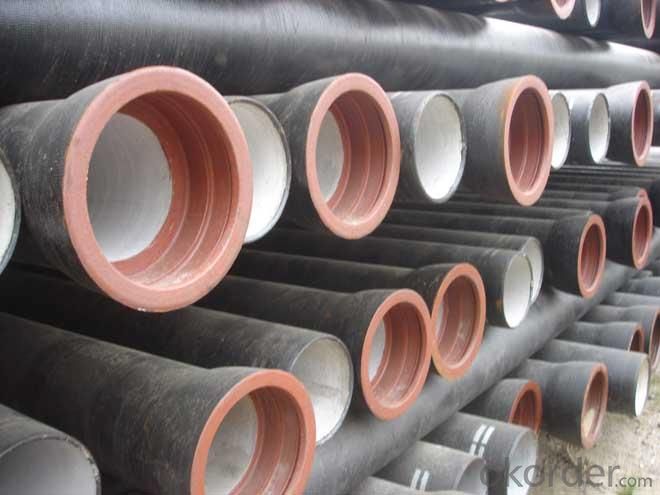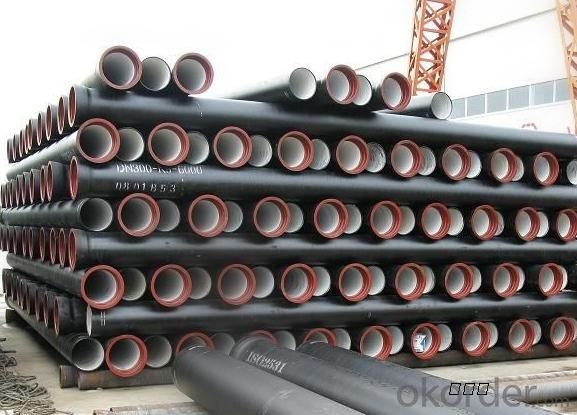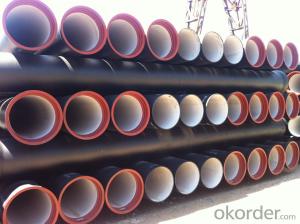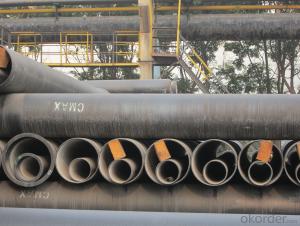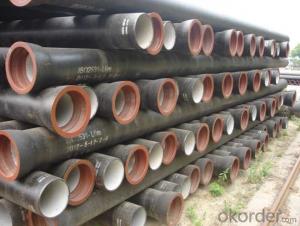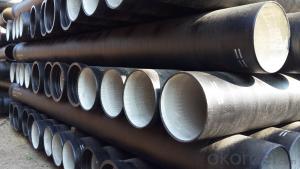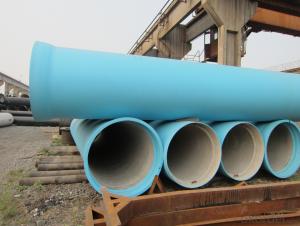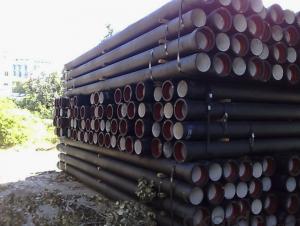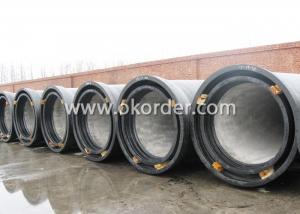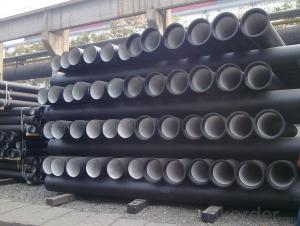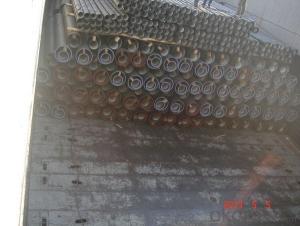Ductile Iron Pipe of China DN150-DN600 EN545/EN598 High Quality
- Loading Port:
- China main port
- Payment Terms:
- TT or LC
- Min Order Qty:
- 20 m.t.
- Supply Capability:
- 200000 m.t./month
OKorder Service Pledge
OKorder Financial Service
You Might Also Like
1,Ductile Iron Pipe Description :
DI pipe fittings are manufactured according to ISO 2531 or BS EN545 or BS4772 FOR POTABLE WATER ,internal is cement lining or wet epoxy coating;External is zinc plus bitumen or wet epoxy coating. We also manufacture ductile iron fittings with fusion bonded epoxy both inside and outside. All the producets are sutible to water pipes fields.
2,Main Features of the Ductile Iron Pipe:
·High yield strength
·High tensile Strength
·High corrosion resistance
·Pressure Resistence
·Anti-corrosion
·Installation is convenient
·Satisfy the highest hygienic standards
. Length: 6m or cut into 5.6m, 5.7m, 5.8m
. Internal Lining: Cement, conform to ISO4179
. External coating: Zinc + Bitumen, conform to ISO8179
. Note: The gaskets, bolts & nuts are supplied respectively as your special requirement
3,Ductile Iron Pipe Images:

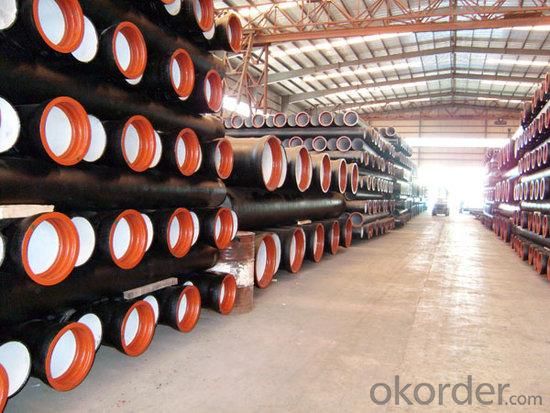
4. Ductile Iron Pipe Specification
Surface Finishes:Bare, Oiled, Mill Varnish, Galv,FBE, FBE Dual, 3LPE, 3LPP, Coal Tar,Concrete Coating and Tape Wrap
End Finishes: Beveled, Square Cut, Threaded, hat
Additional Services: Internal Coating
Packaging: packed in bag, plastic bag, steel strip, steel wire,double wire, iron box, wooden box,
tarpaulin, plastic sheeting
Inspection: MOODY SGS BV GL DNV ABS LIOYD’S
Test :X-ray, UT, magnetic particle,inspection,hydrostatic test.
Processing service :Beveling, Threading, Slotting, Cut-to length, Bends, Quench and Temper, Fabrication, Double-jointing and On-site assistance
Documentary MTC: material certification,Origin certification, CI or PI,Test Report, export licence, handling order, B/L,insurance policy,shipping instructions, contract, packing list etc.
Internal lining: ductile iron pipes shall have an internal cement mortar lining in acc with ISO4179.
External coating: ductile iron pipes shall be externally coated with metallic zinc spray plus a further layer of resin painting to ISO8179.
Gasket: 100% SBR/NBR/EPDM rubber gasket in accordance with ISO4633.
Payment term: L/C, T/T.
Packing: In bulk vessel or in container
5.FAQ:
We have organized several common questions for our clients,may help you sincerely:
1.Q: Why would you choose ductile iron pipe rather than other pipe materials?
A:The reasons are obvious for that not only ductile iron pipe possesses the inherent strength and flexibility of ductile iron, combined with proven corrosion protection systems, but also the cost savings can be achieved from design to installation and commissioning.
2.Q:Why can you guarantee the inner of pipes can’t be corroded?
A: High alumina cement mortar lining and sulphate-resistant cement mortar lining. These two special linings are applicable to inner anti-corrosion for sewage pipes, improving resistance to erosion of the sewage components.
- Q: Can ductile iron pipes be used for mining applications?
- Yes, ductile iron pipes can be used for mining applications. Ductile iron pipes are known for their strength, durability, and resistance to corrosion, making them suitable for various industrial purposes, including mining. Their ability to withstand high pressure and handle heavy loads makes them ideal for transporting water, slurry, and other materials commonly used in mining operations. Additionally, ductile iron pipes have a long lifespan, reducing the need for frequent replacements and maintenance in mining environments.
- Q: What is the minimum pipe diameter of cast iron pipe?
- Nominal diameter of continuous grey cast iron pipe is 75~1200 mm, minimum 75 mm, maximum 1200 mm.
- Q: How does ductile iron pipe perform in seismic areas?
- Ductile iron pipe performs well in seismic areas due to its inherent strength and flexibility. Its ability to withstand ground movement and vibrations makes it a reliable choice for underground infrastructure in regions prone to earthquakes. Additionally, its robust construction and high resistance to corrosion and damage ensure its durability and safety even in seismically active zones.
- Q: How do ductile iron pipes handle thermal cycling in industrial applications?
- Ductile iron pipes are renowned for their exceptional ability to withstand thermal cycling in industrial applications. Thermal cycling refers to the fluctuation in temperature that occurs during the operation of various industrial processes. These pipes are designed to endure the stresses caused by thermal expansion and contraction, thus making them highly suitable for environments with significant temperature variations. One of the noteworthy features of ductile iron pipes is their remarkable thermal conductivity. This means that they efficiently dissipate heat from the hot areas, thereby minimizing the impact of thermal cycling. Furthermore, ductile iron pipes have a low coefficient of thermal expansion, which means that they expand and contract at a slower rate compared to other materials. This characteristic helps to reduce the stresses imposed on the pipes during thermal cycling. Moreover, ductile iron pipes exhibit excellent mechanical properties, including high tensile strength and impact resistance. These properties enable the pipes to withstand the mechanical stresses that may arise due to thermal cycling. They can resist the development of cracks or fractures, ensuring the integrity and durability of the pipes in industrial applications. Additionally, ductile iron pipes possess a high resistance to corrosion and oxidation. This is particularly crucial in industrial settings where the pipes may be exposed to aggressive chemicals or harsh environments. The corrosion resistance of ductile iron pipes ensures that they can endure the corrosive effects of process fluids and gases, even during thermal cycling. In conclusion, ductile iron pipes are well-equipped to handle thermal cycling in industrial applications. Their high thermal conductivity, low coefficient of thermal expansion, excellent mechanical properties, and resistance to corrosion make them a reliable choice for environments with significant temperature variations. These pipes effectively withstand the stresses caused by thermal cycling, guaranteeing their durability and longevity in industrial settings.
- Q: What are the typical surge anticipation measures for ductile iron pipe?
- Typical surge anticipation measures for ductile iron pipe involve implementing various techniques to mitigate the potential damage caused by surges or water hammer in the pipe system. These measures are designed to absorb or redirect the sudden pressure changes, preventing the pipe from rupturing or failing. Some common surge anticipation measures for ductile iron pipe include: 1. Air chambers: Air chambers are installed at strategic points along the pipeline to provide a cushion of air that absorbs the energy generated by surges. As the pressure wave travels through the pipe, the air compresses, reducing the impact on the pipe and minimizing the risk of damage. 2. Surge tanks: Surge tanks are large vessels connected to the pipeline that act as storage reservoirs for excess pressure. When a surge occurs, the surge tank absorbs the excess water volume, preventing it from causing damage to the pipe. The stored water is then gradually released back into the system, allowing pressure to stabilize. 3. Surge relief valves: Surge relief valves are installed in the pipeline to automatically release excess pressure during surge events. These valves open when the pressure exceeds a preset limit, allowing the surge to dissipate harmlessly. Surge relief valves can be adjusted to release the desired amount of pressure, ensuring the safety of the ductile iron pipe. 4. Water hammer arrestors: Water hammer arrestors are devices that absorb the shock generated by surges and water hammer in the pipe system. They consist of a sealed chamber with a compressible gas or liquid that absorbs the sudden pressure changes. By absorbing the energy, water hammer arrestors protect the ductile iron pipe from potential damage. 5. Surge suppressors: Surge suppressors are devices that regulate the flow of water during surge events. They are designed to reduce the speed at which surges travel through the pipe, minimizing the impact on the system. Surge suppressors can be installed at critical points in the pipeline to prevent damage to the ductile iron pipe. It is essential to consider the specific requirements of the pipeline system and consult with experienced engineers or industry professionals to determine the most suitable surge anticipation measures for ductile iron pipe installations.
- Q: Is ductile iron pipe breakable?
- 5, inferior wood surface is easy to produce cracks, because its billet is adobe, Adobe porous, Adobe in the process of cooling due to the role of thermal stress, cracks, after rolling, there are cracks;6, poor drainage tube appearance often pitted phenomenon. Pits is due to groove wear caused by defects in pipe surface irregular uneven. Because of the poor sewer pipe manufacturers to pursue profits, often rolling groove rolling most standard.Ductile iron pipes are broken because of the excessive heat treatment during casting or the lack of proper addition in casting to prevent a change in the proper brittleness and to cause cracking. It is recommended that you used to repair defects of cast iron machine, are currently on the market to sell, but also can ensure welding intact appearance, make your products by quality, but if it is in the use of performance can not meet the effect, especially the pipeline pressure quite big, what methods are of no use that must be re cast as the new.
- Q: DN1800 can the length of ductile iron pipes be several meters? What is the total weight?
- Ductile iron pipe is a kind of cast iron pipe.
- Q: How does ductile iron pipe perform in sandy or unstable soils?
- Ductile iron pipe performs well in sandy or unstable soils due to its inherent strength, durability, and flexibility. Its high tensile strength and resistance to deformation make it capable of withstanding the pressure exerted by the surrounding soil. Additionally, the material's ability to flex and absorb ground movements helps to minimize the risk of pipe failure or damage in unstable soil conditions. Overall, ductile iron pipe provides a reliable and long-lasting solution for transporting fluids in challenging soil environments.
- Q: Are ductile iron pipes suitable for bridge crossings?
- Yes, ductile iron pipes are suitable for bridge crossings. Ductile iron pipes are known for their high strength and durability, making them a reliable choice for various applications, including bridge crossings. These pipes can withstand heavy loads and are resistant to corrosion, which is especially important in bridge crossings where they may be exposed to harsh environmental conditions. Additionally, ductile iron pipes have the ability to flex and withstand ground movement, making them ideal for bridge crossings where the ground may shift or settle over time. Overall, ductile iron pipes offer the necessary characteristics to ensure the safe and efficient transportation of fluids or materials across bridges.
- Q: Are ductile iron pipes resistant to freeze-thaw cycles?
- Yes, ductile iron pipes are resistant to freeze-thaw cycles. Ductile iron is a type of cast iron that has been treated with magnesium, which improves its strength, durability, and resistance to cracking. This enhanced material properties make ductile iron pipes highly resistant to the expansion and contraction that occurs during freeze-thaw cycles. Unlike other materials such as PVC or concrete, which may crack or break under the pressure caused by freezing water, ductile iron pipes have the ability to withstand these cycles without sustaining any significant damage. Additionally, ductile iron pipes have a smooth interior surface that prevents the formation of ice or frost buildup, further enhancing their resistance to freeze-thaw cycles. Overall, ductile iron pipes are an excellent choice for water distribution systems in regions with cold climates, as they offer superior resistance to the effects of freezing and thawing.
Send your message to us
Ductile Iron Pipe of China DN150-DN600 EN545/EN598 High Quality
- Loading Port:
- China main port
- Payment Terms:
- TT or LC
- Min Order Qty:
- 20 m.t.
- Supply Capability:
- 200000 m.t./month
OKorder Service Pledge
OKorder Financial Service
Similar products
Hot products
Hot Searches
Related keywords
